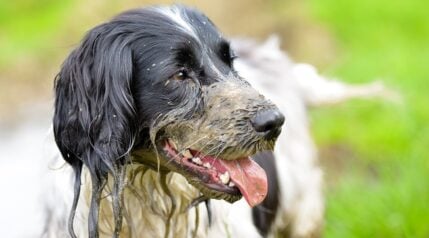If your dog has eaten chocolate, chances are that you know it can be poisonous to dogs. There are several things to consider if your dog has just ingested one of your favorite chocolate bars, and certain types of chocolate are worse than others.
While dogs eat many things they shouldn’t, Chocolate is one of them that could be potentially serious. Knowing exactly what to do in order to lessen the impact of this is key to making sure you are well-prepared for emergencies that come your way.
The first thing you need to do if your pup consumed chocolate is to make a call to your veterinarian. With that being said, this guide is set up to make sure you know everything you need about chocolate consumption in dogs. You’ll learn how much of it is bad and what you should do next. Let’s jump in!
Why Eating Chocolate Is A Concern
We are always grateful to receive gifts of chocolate at our veterinary practice, unfortunately, less so when it’s already inside your dog’s stomach. It contains a substance called theobromine which is toxic when eaten by dogs. It has adverse effects on the central nervous system (brain) as well as on the heart and respiratory (breathing) system. All of these are very important to maintain a happy and healthy dog!
It has been reported that approximately 1 in 4 cases of toxic ingestion or poisoning seen in dogs that require treatment at veterinary practices involve chocolate. In my experience, certain times of the year seem to be higher risk. More toxicity cases involving chocolate are seen during the months around Christmas and Easter when there are more ‘goodies’ lying around for dogs to gain access to. Halloween is another common time of year for dogs to present with chocolate poisoning.
There are many other foods commonly eaten within the home that are actually toxic to dogs. This includes dried fruits like raisins or grapes, onions, and alcohol. It’s very rare that any of these foods are given to pets with the intention of harming them or making them ill.
More often than not, the dogs have helped themselves or have been fed them as treats. Oftentimes, their owners don’t realize the damage these foods can do. The aim of this article is for us to help you understand why chocolate shouldn’t be eaten by your dog, what the risks are, and what to do and expect if it has been eaten.
Theobromine Toxicity

The chemical Theobromine is an alkaloid and is in the same group of substances as caffeine. Both of these substances are found in chocolate and are toxic to dogs. Theobromine is found in the cacao plant – which is what cocoa and chocolate are made from. It is bitter tasting, but when mixed with sugar and other ingredients, it can make it taste very appetizing (as I’m sure many of us would agree).
Dogs cannot metabolize theobromine or caffeine as well as people can. When eaten by dogs, it causes incorrect processing of calcium within their bodies, as well as a few other effects. Calcium is integral to allowing the correct contraction and movement of all muscles within the body, including the heart muscle.
Due to this calcium dysregulation, both theobromine and caffeine have stimulatory effects on the heart muscle. They also cause dilation of the blood vessels, relaxation of smooth muscle within the body (such as that lining the gut), and have diuretic effects (causing increased urination and possible dehydration). This is one of the reasons why we can feel a bit jittery or get a ‘caffeine rush’ after a strong coffee or lots of chocolate!
Any side effects will depend on the type of chocolate that has been eaten, when it was eaten, the size of the dog, and what happens afterward. The effects can range from mild to very serious and, ultimately, in the worst (thankfully rare) cases, death. In cases where death does occur as a result of chocolate poisoning, it is usually in dogs that already have health issues such as heart disease.
Dark, Milk, Or White Chocolate?

The theobromine content in different types of chocolates varies widely. The highest amounts are found in dark chocolate and baking cocoa powder. The lowest amounts are in white chocolate.
Just to give you a clearer idea of this, the theobromine content in milligrams (mg) per gram (g) of chocolate is approximately:
- White Chocolate: 0.009mg/g
- Milk Chocolate: 2mg/g
- Dark Chocolate: up to 16mg/g
The worst culprits found in your kitchen are cocoa powder, where levels can be as high as 26mg/g. The quoted fatal dose of theobromine in dogs (i.e., the dose that can KILL a dog, not just make it ill) is anywhere between 90-250mg/kg. This means that a 30kg Bulldog eating a 200g bar or box of dark chocolate would eat 106mg/kg and could potentially die as a result. Anything above 12mg/kg is likely to cause symptoms associated with the toxin.
One particularly memorable case I had was a dog that ate a whole dark chocolate orange. It was wrapped up as a Secret Santa gift for the owner’s work colleague and left on the kitchen side. This hefty ball of dark chocolate weighed in at 157g, a fatal dose for this dog. Thankfully, the owner noticed what had happened and quickly brought their pet to us for treatment. Their swift response meant that their pup made a full recovery. We’ll take a look at the treatment for chocolate poisoning a little later on.
What Will Happen To My Dog?

Symptoms will depend on the amount of chocolate eaten and the size of the dog. It will also depend on the source. If your dog ate an Oreo, that’s different than a bar of dark chocolate or a protein bar. The most frequently seen side effects are vomiting and diarrhea, abdominal (tummy) pain, drinking and urinating more, restlessness, hyperactivity, and a high heart rate. None of those are particularly pleasant, but in mild cases, they’re not life-threatening.
In severe cases, these may progress to blood in your dog’s urine or vomit. Your pup may struggle to breathe and have lower oxygen levels within the blood. This may be seen as a purple or blue tinge to the gum or tongue color. Other symptoms are hyperthermia (high body temperature), muscle tremors, or convulsions. Your dog may also experience an irregular heart rhythm (or heart failure) and occasionally sudden kidney failure or death.
There are also other ingredients in chocolate that cause it to have a high fat and sugar content. These can cause tummy upsets and, in some more severe cases, pancreatitis. This can be very serious in some dogs, especially those which are prone to it or are older.
If there’s a chance that your dog has also eaten packaging (this might be wrappers, cardboard, or plastic) or if there were whole nuts in the chocolates, then there is a slight risk that these could cause a physical blockage within your pet’s guts. It’s really important to monitor for any signs associated with this.
Can Problems Be Treated?
Milder signs such as vomiting and diarrhea are often managed symptomatically with a bland diet and occasionally medications from your vet. There is a risk of dehydration as a result of fluid loss (through vomiting and diarrhea). It’s important to try and avoid this. If your dog is usually on dry food (biscuits), it might be advisable to add some water to this. Encourage them to drink using water flavored with a little boiled chicken.
I do NOT advise withholding food at any point for dogs with vomiting or diarrhea. Instead, feed bland, wet foods in small frequent amounts. Your vet can provide you with a bland diet specifically designed for dogs with gastric upsets.
In more severe cases, animals may require hospitalization. In the hospital, expect intravenous fluids (drips), medications, blood tests, heart monitoring equipment, and other intensive care. For dogs with underlying diseases such as heart disease, previous history of pancreatitis (painful inflammation of the pancreas), or other issues, the care required may be higher, and the chances of a positive outcome may be lower.
This was how I needed to treat a dog that had eaten chocolate-coated coffee beans. The combination of the theobromine in the chocolate and the caffeine in the coffee beans meant we had to monitor this dog closely. With decontamination, blood tests, and intravenous fluids, the dog made a good recovery. Things could have been very different if the owner didn’t bring their pet in promptly.
As you can imagine, though, the costs of treatment can quickly mount up, and this includes both financially and emotionally for all involved. Prevention is always better than cure.
My Dog Ate White Chocolate: What Now?
Although the theobromine content may not be high enough to be a toxic concern, the sugar and fat content can still cause problems such as gastroenteritis (tummy upsets) and/or pancreatitis. So if your dog has ‘only’ eaten white chocolate, you still can’t be too complacent.
They may still develop vomiting and diarrhea. If symptoms do not improve quickly on their own can be very serious. This is a particular concern in old or young dogs. They can become dehydrated quickly, which can lead to organ damage and weakness.
My Dog JUST Ate Chocolate: What Now?
Just like when they eat other harmful objects like chicken bones, the best advice is to call your veterinary surgeon as soon as possible. Once a dog has eaten chocolate (or anything else), it takes around 2-6 hours for the food to move from the stomach into the intestines. If your dog has eaten a toxic amount within the previous 2 hours, your vet is likely to offer to see your pet to make them vomit.
The aim of this is simple: to ‘decontaminate’ and remove as much of the chocolate from the stomach as possible. This reduces the amount of theobromine absorbed into the body. Do NOT try making them sick at home unless directed to by your vet. Most ‘home remedies’ are toxic, causing severe damage, and if they don’t work can leave your vet with no options in the clinic.
Keep in mind that some candies, cakes, or other foods like brownies may have chocolate inside of them. Your dog may react less severely to these items if they were made with a lower chocolate content. You should always call your vet if you have concerns.
What Happens At The Vet’s Office?

If you know what type of chocolate your dog has eaten, hold on to the wrapper. It can be useful to take the packet with you to the vet or make a note of it. It’s handy for your vet to know the type of product that’s been eaten. It’s possible it might contain any other toxins (such as dried fruit or certain types of nuts), and whether there might be wrappers, parts of packaging, or anything else that your dog has eaten.
Your vet will take a history from you and perform a quick examination of your dog. It’s important to mention at this stage if your dog has any previous problems or is on any medications. Don’t be surprised if things move quite quickly once you arrive at the vet’s office. Your vet may take your dog away from you to be sick and then return to get more information from you. This is because time is of the essence. Your vet may also ask for you to stay with your dog while they are sick, especially if they are short-staffed.
The vet will make your dog sick using an injection. I find that this usually works within a couple of minutes, and its effects don’t last that long. It’s all over in 15-45 minutes. Once your dog has stopped being sick, your vet may offer them a small amount of food to help settle their tummy. This depends on the vet and the dog. Not all dogs will want to eat after being sick. Although, in my experience, approximately 95% of Labradors do.
Your dog should be fed a bland diet for the next 24-48 hours and monitored for any concerns. Caffeine is also reabsorbed from the lining of the bladder. So, ensure your dog is allowed outside to encourage frequent urination. You may find that he or she still shows mild signs of toxicity. These are most likely to be gastrointestinal (tummy) upsets such as vomiting or diarrhea.
Not Sure When It Was Eaten, What Next?

If your dog ate the chocolate longer than 4 hours ago, then there’s usually very little benefit to making them sick. However, if there’s any chance that it could have been within this time, and particularly if you think your dog has had a high level of theobromine (i.e., dark or milk chocolates), then it might still be worth trying.
Your vet may prescribe activated charcoal to mix into your dog’s food or give it via a syringe. This is designed to bind any toxins in the gastrointestinal tract and therefore reduce the amount absorbed. Please note that this is NOT “just” charcoal. It is a veterinary prescription liquid. Charcoal will not have the same effects, and we strongly recommend that you don’t feed it to your dog.
It can take up to 10 hours for theobromine to be completely absorbed into the dog’s bloodstream. Those first few hours are key to treatment. Once it has left the dog’s stomach, we, as vets, are unable to help remove it. But it’s important to remember that even if your dog doesn’t appear to have negative side effects straight away, they aren’t in the clear for at least 24 hours. This is due to the length of time it takes for the theobromine to be absorbed and the symptoms to show.
Feed your dog a bland diet. Ensure they have access to fresh water and are allowed frequent trips outside to go to the toilet. Monitor closely for any symptoms. If you have any concerns over the following 24-48 hours, please call your vet for advice.
If your dog is showing any symptoms such as hyper-excitability, muscle tremors, seizures, or collapse, then you should contact your vet immediately. These are symptoms of toxicity and require an urgent assessment, monitoring, and treatment from your vet.
Reducing Your Risks
The easiest way to make sure you are never in this situation is to make sure there are no goodies lying around that your dogs can gain access to and scoff. This means nothing is left on the worktops, and cupboard doors should be shut. Children are often the culprits. Make sure they know to lock their goodies away, especially at Easter. And ensure that any chocolatey-shaped parcels under the Christmas tree are kept out of reach until the big day. I’ve even seen chocolate advent calendars get munched in the past too. Always plan for the worst-case scenario and assume that even dogs with good track records will eat things they shouldn’t if they can get to them.
One of the most important things that you can do is make sure that all members of your family are aware that chocolate is toxic and also about the potentially very serious side effects (and the vet bill!) that could result. If everyone is on the same page, it’s much easier to help keep our pets safe.
If you do find yourself in a situation where your dog has eaten chocolate (and accidents do still happen sometimes, despite our best efforts), please call your vet to discuss it immediately. They might simply tell you not to worry, but they’re best placed to help you to decide on a course of action.





